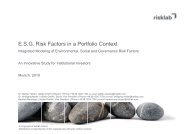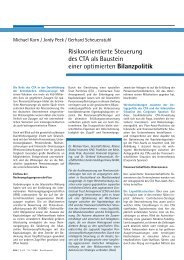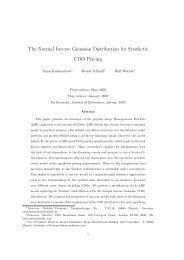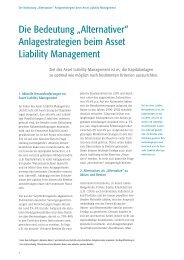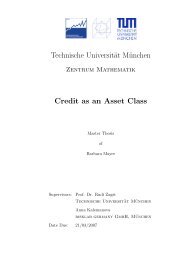Technical University Munich Commodities as an Asset Class - risklab
Technical University Munich Commodities as an Asset Class - risklab
Technical University Munich Commodities as an Asset Class - risklab
You also want an ePaper? Increase the reach of your titles
YUMPU automatically turns print PDFs into web optimized ePapers that Google loves.
2.1 The different Commodity Types<br />
in the same way like petroleum <strong>an</strong>d occurs to 30% in combination with its liquid<br />
brother <strong>an</strong>d to 70% in independent fields. Figure 2.5 shows its price <strong>an</strong>d net consumption<br />
development over the l<strong>as</strong>t 35 years in the scale of oil equivalent for better<br />
comparison.<br />
Figure 2.5: Natural G<strong>as</strong> Price <strong>an</strong>d Net Consumption<br />
Natural g<strong>as</strong> prices are by far not that volatile <strong>as</strong> crude oil prices are <strong>an</strong>d are by<br />
far not that reactive to political queries because it does not have the import<strong>an</strong>ce<br />
in world’s industry, yet. It c<strong>an</strong> be seen <strong>as</strong> a substitute to crude oil what is getting<br />
specially in <strong>an</strong> high oil cost environment more popular. Its major drawback to<br />
petroleum is that is comes <strong>as</strong> a g<strong>as</strong>. Therefore, its volume is thous<strong>an</strong>d times that of<br />
its liquet brother. Since the 1960s there exist procedures which cool down natural<br />
g<strong>as</strong> until it goes over into the liquid state of aggregation. In this form it c<strong>an</strong> be<br />
stored <strong>an</strong>d shipped or driven to its place of destination. This procedure is more<br />
complicated <strong>an</strong>d cost intensive <strong>as</strong> the storage <strong>an</strong>d tr<strong>an</strong>sportation of oil. Therefore,<br />
the industrial use of natural g<strong>as</strong> becomes economically justifiable only in a high oil<br />
cost environment.<br />
As we’ve already mentioned, there are different movements to switch from oil b<strong>as</strong>ed<br />
products to alternative energy sources what explains the higher consumption growth<br />
rates of 2.5% on average over the l<strong>as</strong>t 10 years in comparison to crude oil which usage<br />
h<strong>as</strong> been grown on average 1.7% over the l<strong>as</strong>t 10 years. 15 Natural g<strong>as</strong> c<strong>an</strong> be used<br />
to substitute traditional heating <strong>an</strong>d electricity sources. M<strong>an</strong>y households already<br />
started to switch their heating fuel from oil to g<strong>as</strong> what incre<strong>as</strong>ed its dem<strong>an</strong>d. Over<br />
this, car m<strong>an</strong>ufacturers are working to get fuel cell b<strong>as</strong>ed motors ready for commercial<br />
use. First test series have been successfully but bulk production stills needs<br />
15 See [BP Report 2006].<br />
13



